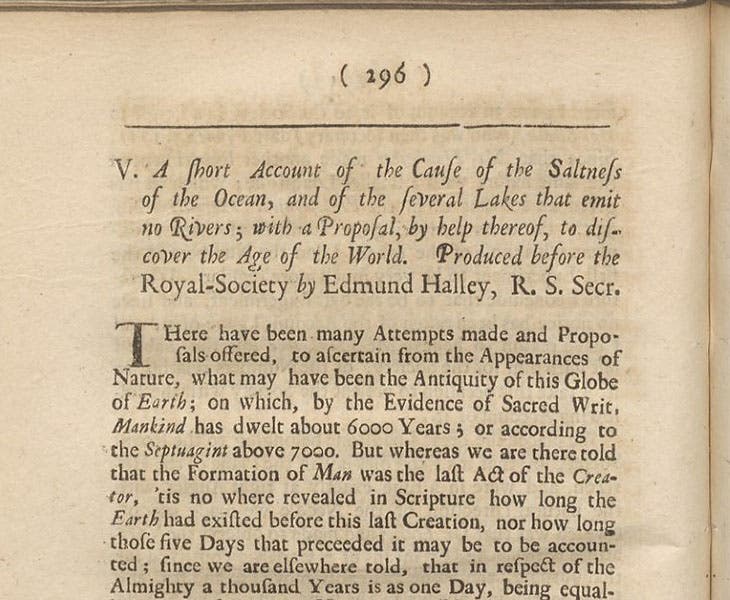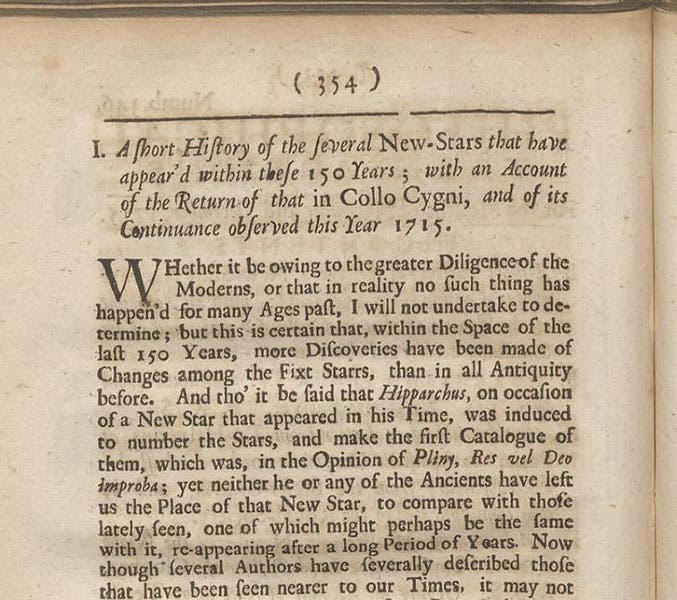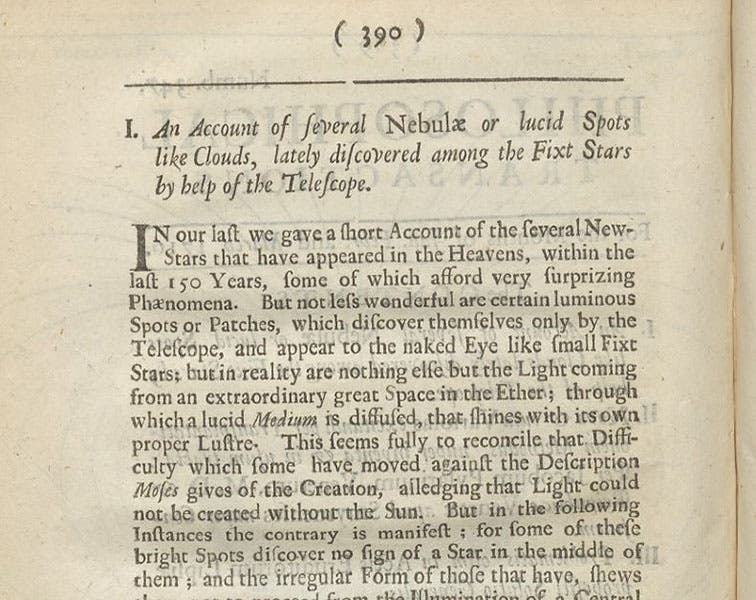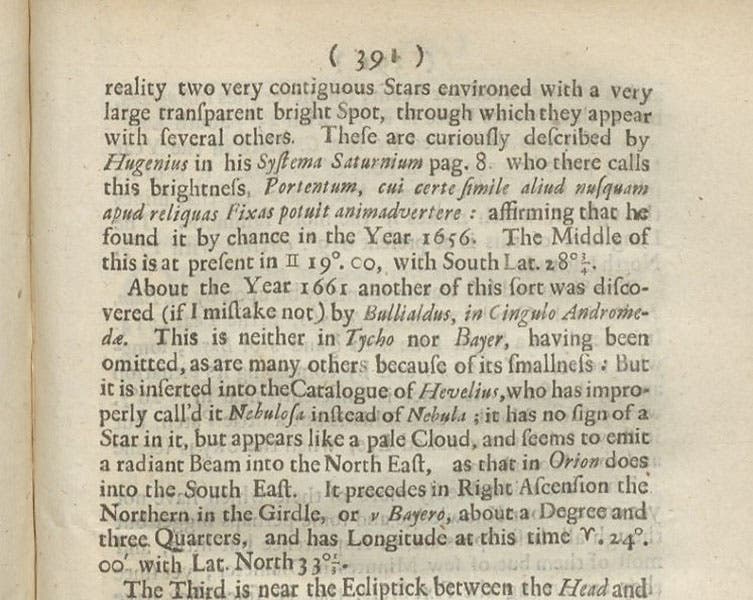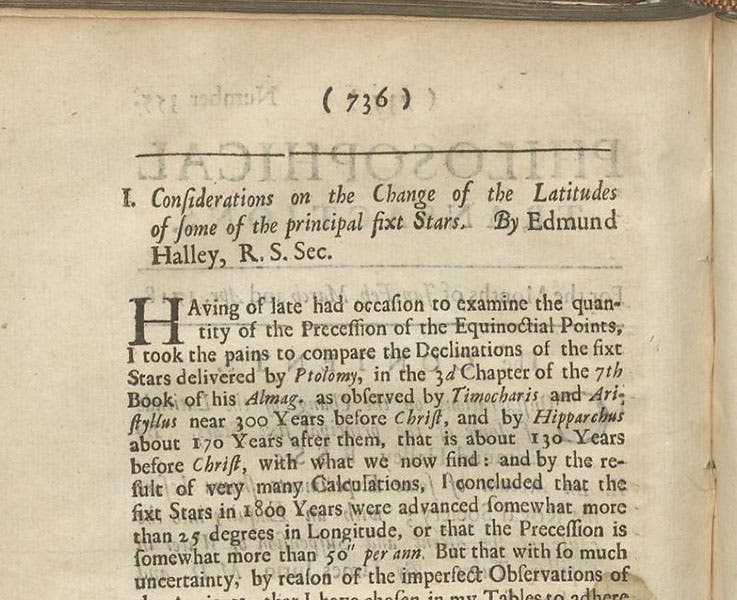Scientist of the Day - Edmond Halley
Edmond Halley, an English astronomer, was born Nov. 8, 1656. Three years ago, we celebrated Halley’s best-known achievement, the discovery that the comet of 1682 is a periodic comet, which had previously appeared in 1535 and 1607 and would do so again in 1758. When the comet appeared as predicted, Halley was hailed as an astronomical wizard, and his name has been attached to the comet ever since.
But Halley should be remembered for more than this, because not only was he one of the most original thinkers of his time, he also had the belief, uncommon in his time, that we can learn from the historical past, even in the field of astronomy. Moreover, he was very good at writing short “thought pieces,” essays that might well begin: “I wonder…” We are going to discuss four of those today, and could discuss twice as many, if we had the time and space.
In 1713, Halley became secretary of the Royal Society of London, and one of his responsibilities was editing the Philosophical Transactions of the society. This meant that he could, if he so desired, write editorials, even though none of the editors before him had done so. Volume 29 of the journal, containing issues from 1714-16, has quite a few of these sometimes unsigned pieces, and some of them are breathtaking in their originality. For example, Halley published a brief note called: "A short account of the Cause of the Saltness of the Ocean" (second image, above), in which he proposed that one could calculate the age of the Earth by assuming that the newly formed Earth had fresh-water oceans and then determining the rate at which salts are deposited in the ocean by rivers. Almost 200 years later, John Joly had the same idea and was widely hailed by his contemporaries for his inventiveness. No one knew until 1910 that Halley had anticipated them all.
Fifty pages and two issues later, Halley published “A short History of the several New-Stars that have appear'd within these 150 years” (third image, above). Here he disdplayed his skills as an astronomical historian by summarizing what astronomers had learned about novelty in the heavens in the past 150 years. He pointed that the new stars of 1572 and 1604, often referred to as Tycho’s star and Kepler’s star, were not the only changing stars detected by astronomers. There had been one in 1596, and another in 1600, and others in 1670 and 1686. Some of these had faded out and then reappeared, and one of them seemed to be regularly variable, waxing and waning every 330 days. It does not seem like such a remarkable paper to many today. But before Halley, no one had really noticed that new and variable stars seem to be a feature of the heavens that need to be accounted for.
In the next issue, Halley published "An Account of several Nebulae or lucid Spots like Clouds, lately discovered among the Fixt Stars by help of the Telescope" (fourth image, above). Here Halley did for nebulae what he had just done for new stars: he listed all the ones that were known, credited the discoverers, pointed out how the nebulae differ from one another, and wondered what they might actually be. The list included the Great Nebula in Orion which he credited to Christiaan Huygens, the Andromeda nebula sighted by Ismael Boulliau (fifth image, below), and the two spherical nebulae in Centaurus and Hercules that Halley himself had first discovered. The search for nebulae was going to be a hot astronomical enterprise in the 1770s, and it all started with Halley’s short paper of 1716.
We have room to discuss one more of these Halley editorials, and we choose a paper that appeared early in the next volume, volume 30, compiled in 1717-19. It is titled: “Considerations on the Change of the Latitude of some of the principal fixt Stars" (sixth and seventh images, below). Here Halley showed both his historical and astronomical skills. He discussed three stars whose positions had been determined by the ancient astronomers Ptolemy and Hipparchus: Palilicium in Taurus (now called Aldebaran), Sirius in Canis major, and Arcturus in Bootes. Each of these stars had changed in latitude since ancient times, some by as much as half a degree. Halley showed that the changes cannot be accounted for by assuming the ancient observers were mistaken, not was it a systematic shift, like precession – some stars moved north, and some south. His conclusion was that the stars are not fixed after all, but move independently through space. Each star has its own “proper motion,” as it would soon be called. This seems like a minor discovery, but to Halley’s successors, it was galvanizing. “The stars are interesting after all”, they seem to have realized. “Perhaps we should study the stars, measure their proper motions, and perhaps find a way to determine their distance and their arrangement in space.” Stellar astronomy as a profession began with Halley’s short thought-piece of 1718.
There were more of these short papers by Halley in the Philosophical Transactions, in which he mused about such matters as the distribution of stars in space, and wondered why, if the stars are infinite, the sky isn’t ablaze with light, discovering Olbers’ Paradox a century before Olbers. It was a remarkable series, and one wonders why, after his death in 1743, no one published a volume called Halley on the Universe: Collected Papers. Less than 30 pages long, it would have provided a welcome jumpstart for the next century for astronomers wondering what to do next. Indeed, one wonders why such a volume is not in print right now.
In our first post on Halley, we showed, for some reason, a portrait of an older Halley, painted in 1721, which would have been more appropriate for today’s discussion. So today we show you a portrait of Halley painted around 1690, when he was probably thinking about comets and universal gravitation, and not about the stars (first image).
Dr. William B. Ashworth, Jr., Consultant for the History of Science, Linda Hall Library and Associate Professor emeritus, Department of History, University of Missouri-Kansas City. Comments or corrections are welcome; please direct to ashworthw@umkc.edu.


